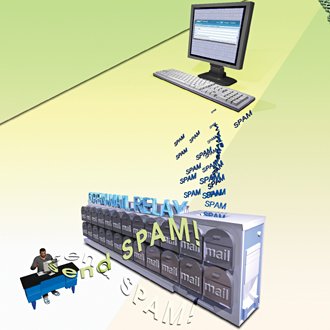Chapter 13. How Spam Worksand How to Fight It
| What is the most annoying thing that people face when they use the Internet? Spam. Nothing else even comes close to being as annoying as spam. Unwanted email clogs all our inboxes, floods us with pornographic come-ons, and gets worse with each passing year. The term spam comes from a Monty Python skit in which every item on a menu contains Spam luncheon meat. It was originally used to refer to unsolicited postings for commercial products or services on Usenet, especially when they were cross-posted to several newsgroups. How bad is the problem? Postini, an email security and management company, claims that 88% of all email sent is spam. And security company MessageLabs claims that 69% of all email sent in 2005 was spam. You might not get quite that much spam, but that's only because not all spam directed at you actually reaches you. Internet service providers (ISPs) and private businesses spend a significant amount of money every year filtering out spam before it reaches its intended recipients. Spam has one purpose, and one purpose alone: to make money for spammers. Their emails are come-ons to click and get sent to a site, such as a get-rich-scheme or to buy phone pharmaceuticals. In some instances, such as in the infamous Nigerian 419 scam, millions of dollars have been lost to scammers who empty people's bank accounts. Most people have never clicked a piece of spam or bought anything from a spammer. So one would think that spam is not cost-effective and would eventually go away. Unfortunately, though, spam is here to stay. That's because the cost of sending spam is minisculeit's not as if spammers have to pay 39 cents for a stamp for every piece of spam they send. In some ways, spam is not very different from traditional junk mail. A spammer buys or compiles massive lists of email addresses. The spammer then either uses special software to send the spam or hires a hacker to use his fleet of hijacked PCs, called zombies or bots, to send the spam. Spam might seem like a minor annoyance, but it's much worse than an annoyance. It leads to scams, clogs the Internet, and floods mail servers with unnecessary messages. Some estimates hold that spam costs businesses an astonishing $20 billion a year in lost productivity, buying extra hardware and software, and troubleshooting costs. A variety of methods have been devised to block spam, including having email filters on email software ignore any mail from known spammers. This doesn't always work, however, because spammers often change or forge their email addresses. Congress stepped into the anti-spam wars in 2003 with the Can-Spam Act. But the law, by all accounts, has been so watered down that it has had no effect at all on spam. In fact, there are those who say that because it legalized certain forms of spam, it legitimized the practice. Since the law's passage, spam has skyrocketed. Ultimately, the solution is more than legislative. It's in technology and changing people's behavior. If no one ever clicked a piece of spam, spam would disappear. And a variety of technological solutions are being called for, including a way of verifying the true sender of every piece of mail sent over the Internet. But those solutions may never come to fruition. Most likely, like it or not, spam is here to stay. |
EAN: 2147483647
Pages: 161
